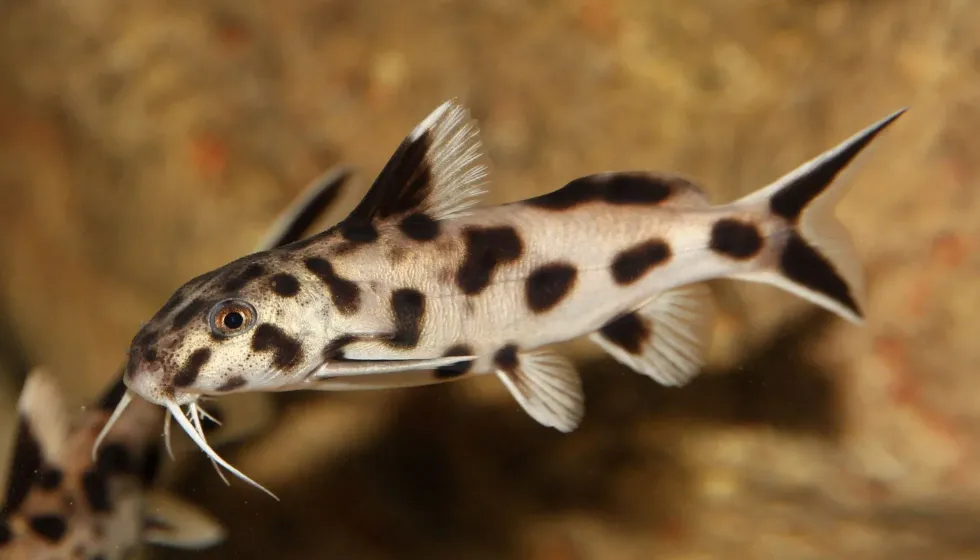The Synodontis polli, also commonly known as Poll's synodontis, is a catfish that is a member of the Mochokidae family, whose members are also referred to as upside-down catfish or squeaker catfish! It is found mainly in a famous freshwater lake in Africa, Lake Tanganyika, which is the second-oldest, second-deepest, and second-largest lake in the world.
It has also been observed to occur in the Democratic Republic of Congo, Burundi, Zambia, and Tanzania. It can be found inhabiting muddy bottoms of lakes with hard water conditions where the water is clean and the pH is stable.
The typical Synodontis polli body shape is compressed, with its head being described as compressed too. Its mouth has wide lips.
The base color of the head and the body can be brown to creamy white, and there are black marks all over its body. Its underside is lighter, however.
The caudal, pectoral, and dorsal fins have white-colored outer edges and are of a similar color to the body. The fins turn black towards the outer borders eventually.
The caudal fin is forked and has round lobes. Its length ranges between 5.7-7.1 in (14.5-18 cm).
The Poll's Synodontis is omnivorous and feeds upon a wide variety of foods. Keep reading to go deeper into the world of the Synodontis polli!
If you enjoyed reading our Synodontis polli fun facts, you must check out our gulf toadfish surprising facts and shortnose gar facts for kids!
Synodontis Polli Interesting Facts
What type of animal is a Synodontis polli?
The Synodontis polli, also commonly known as Poll's synodontis, is a fish that belongs to the family Mochokidae and is commonly found in Lake Tanganyika in Africa. Its family (Mochokidae) is a family of catfish and its members are also referred to as upside-down catfish or squeaker catfish!
What class of animal does a Synodontis polli belong to?
Synodontis polli is a fish species that belongs to the class of Actinopterygii.
How many Synodontis pollies are there in the world?
The exact population of the Synodontis polli is unknown, however, its population is abundant in Lake Tanganyika.
Where does a Synodontis polli live?
The Synodontis polli species inhabits inland waters. It is a freshwater fish species whose distribution is not widespread. It is endemic to the famous lake in Africa, Lake Tanganyika. It has also been observed to occur in the Democratic Republic of Congo, Burundi, Zambia, and Tanzania.
What is a Synodontis polli's habitat?
The Synodontis polli species of catfish's habitat comprises freshwaters with a pH in the range of 8.5-9 and a temperature in the range of 72-79 F (22.3-26.1 C). This fish species prefers to reside in hard water conditions where the pH is stable and the water is clean.
It inhabits rocky coasts at the shore of a lake and can be found at a depth of 66 ft (20 ft), implying that it prefers dim-lit waters.
Who does the Synodontis polli live with?
The Synodontis polli can live with other fish species like cichlids, African rift lake catfish, large barbs, and large tetras. Its mates in the aquarium shouldn't be very aggressive.
It has been observed that males of this species may fight with and attack other new additions until separate territories have been established. In its natural environment in Lake Tanganyika, there are 250 species of cichlids residing alongside the Synodontis polli.
How long does a Synodontis polli live?
The Synodontis polli can live for many years if excellent water conditions and food are provided. Their exact lifespan is not known.
How do they reproduce?
There are a few reports of the Synodontis polli spawning in an aquarium. These fish are given hormone injections for successful aquarium breeding.
In their natural habitat, spawning takes place during the flooding season, which is between the months of July and October. They are egg scatterers and the breeding pair swims in unison when they are spawning. The growth of the fry of this fish species is quite fast in their first year.
What is their conservation status?
Synodontis polli fish do not have a wide distribution, however, they are abundant within their range. Their conservation status is Least Concern as per the IUCN.
Synodontis Polli Fun Facts
What do the Synodontis polli look like?
The typical Synodontis polli body shape is compressed, with the head being described as compressed too. Its mouth has wide lips and its mouth has 40-70 teeth within it which are unicuspid, short, and are organized in six or eight transverse rows.
The base color of the head and the body is brown to creamy white, featuring black marks all over its body. Its underside is lighter, however.
The caudal, pectoral, and dorsal fins have white-colored outer edges and are of a similar color to the body. The fins turn black towards their outer borders eventually. The caudal fin is forked and has round lobes.
Its length ranges between 5.7-7.1 in (14.5-18 cm). The fry (babies) of this species are lighter in color and have a brighter fin with white-colored edging.
They exhibit sexual dimorphism with males being larger than females. The bellies of females are rounder than those of males.

How cute are they?
The Synodontis polli is a cute catfish that can be an adorable aquarium pet. It has distinctive black marks all over its brown body, making it look quite magnificent.
How do they communicate?
This fish species communicates by rubbing its pectoral fin's spine with its shoulder groove to produce a squeaking sound.
How big is a Synodontis polli?
The Synodontis polli has a short length as compared to other catfish. Its length ranges between 5.7-7.1 in (14.5-18 cm). Male Synodontis polli fish are robust and larger than females. This fish's length is twice the length of the rainbow cichlid!
How fast can a Synodontis polli swim?
The speed of this species has not been evaluated yet, however, it is known to be able to swim upside down, with its belly facing up, and can easily catch food while swimming!
How much does a Synodontis polli weigh?
The weight of the Synodontis polli has not been evaluated yet.
What are their male and female names of the species?
There is no particular name for males and females of this catfish species.
What would you call a baby Synodontis polli?
The baby of a Synodontis polli is referred to as fry.
What do they eat?
They feed upon crustaceans and insects in the wild. In captivity, they must be fed flake foods, frozen and live foods, spirulina, sinking foods such as catfish pellets, tablets, and frozen bloodworms, as well as prawns and mussels.
Are they dangerous?
The Synodontis polli fish is not dangerous to humans. However, they are very territorial in a tank and can get aggressive with their tank mates.
Would they make a good pet?
Yes, Synodontis polli make great pets. Their aquarium must be dimly lit and must possess rocks and bogwood with aquatic plants to provide shelter.
The tank must mimic the natural environment of this species of fish, just like Lake Tanganyika. The water quality must be excellent with a stable pH as they cannot survive in poor quality water. They can be kept with other species like cichlids, barbs, and tetras, which are not very aggressive.
Did you know...
A catfish can survive for 15-18 hours after they have been fished out of the water!
How many teeth do the Synodontis polli have?
Their mouth has 40-70 teeth within it. These are unicuspid, short, and are organized in six or eight transverse rows.
How many eggs do the Synodontis polli lay?
The number of eggs the female Synodontis polli lays is currently unknown. However, we do know that they are egg-scatterers.
Here at Kidadl, we have carefully created lots of interesting family-friendly animal facts for everyone to discover! Learn more about some other fish from our three spot gourami fun facts or strawberry grouper interesting facts pages!
You can even occupy yourself at home by coloring in one of our synodontis polli coloring pages!










